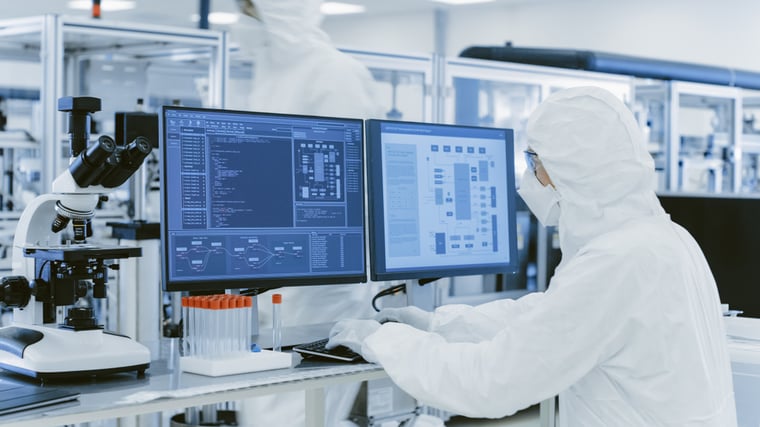
Charting the future of bio-detection: exploring innovation pathways
August 2023
By Dr Claire Lebouteiller, Senior Consultant - Medical Devices at 42T
In the ever-evolving landscape of infectious diseases, the importance of rapid and accurate bio-detection has never been more vital.
From the tumultuous emergence of the COVID-19 pandemic to the persistent threat of cattle and livestock diseases, and from environmental monitoring to preparedness against bioterrorism, the need for robust bio-detection technologies has been starkly underscored.

As we stand on the cusp of a new era marked by advanced scientific breakthroughs and innovative technologies, the imperative to enhance the efficacy, sensitivity, and speed of bio-detection has never been more urgent.
Here we explore the avenues through which bio-detection methods can be improved, propelling us toward a future of more accurate, efficient, and adaptable disease diagnostics.
Embracing technological advances
The cornerstone of improving bio-detection methods lies in embracing cutting-edge technologies. The integration of novel biosensors, nanotechnology-based assays, advanced imaging techniques, and innovative signal amplification methods promises to heighten sensitivity, specificity, and speed.
By harnessing these tools, we can unlock the potential to detect even the most elusive pathogens, ensuring early and accurate diagnoses. Investment in research and development will be pivotal in harnessing the true power of these technologies to transform the landscape of bio-detection.
Enhancing multiplexing capabilities
Multiplexing, the simultaneous analysis of multiple pathogens in a single test, is a game-changer in bio-detection. It enables comprehensive analysis and faster results, in a single piece of equipment.

To enhance multiplexing capabilities, the focus is on the development of high-throughput versatile screening platforms, such as next-generation sequencing, and multiplexed assays.
This approach not only expedites disease surveillance but also enables the identification of genetic diversity, antimicrobial resistance, and virulence factors in pathogens, paving the way for more informed intervention strategies.
Pioneering miniaturisation and automation
Advances in microfluidics and lab-on-a-chip technologies offer a transformative pathway to improved bio-detection. By integrating complex bio-detection processes into compact and automated platforms, we can reduce reliance on specialized laboratories, minimize turnaround times, and enhance accessibility.

These miniaturized and automated systems democratize access to bio-detection, making it possible to deploy sophisticated diagnostics even in resource-constrained settings.
Unleashing the power of AI and machine learning
The integration of artificial intelligence (AI) and machine learning holds immense potential in revolutionizing bio-detection methods. These technologies can analyse complex data patterns, aiding in the interpretation of results and contributing to disease outbreak predictions.
By leveraging AI algorithms, we can delve into the intricate relationships between pathogen behaviour, genetic makeup, and individual attributes, paving the way for personalized treatment strategies.
Improving connectivity and data sharing
The future of bio-detection hinges on seamless connectivity and data sharing. Developing tailored Internet of Things (IoT) software can create an ecosystem where bio-detection devices communicate in real-time, streamlining data collection and analysis.
This interconnected network enhances response times, facilitates global collaboration, and bolsters early warning systems for both disease outbreaks and environmental threats.
.webp?width=762&height=346&name=shutterstock_1727728051%20(5).webp)
Tackling trade-offs through iterative refinement
While the ideal bio-detection method encompasses speed, accuracy, and portability, achieving this trifecta often involves navigating trade-offs. We can tackle these trade-offs through iterative refinement and optimization.
Focus on improving thermal cycling technology and microfluidics sample pre-treatment to enhance speed and portability. Invest in refining detection systems by optimizing hardware design and deploying noise reduction algorithms to elevate accuracy.
Devote attention to developing algorithms that enable the extraction of meaningful insights from complex data patterns, thereby furthering understanding and predictability.
Collaboration is essential
The quest to improve bio-detection methods is a dynamic and multifaceted endeavour that requires the collaborative efforts of scientists, engineers, and healthcare professionals.
%20(1).webp?width=760&height=428&name=shutterstock_691541086%20(1)%20(1).webp)
By embracing technological advancements, enhancing multiplexing capabilities, miniaturizing, and automating processes, leveraging AI, and optimizing connectivity, we can propel bio-detection methods toward an era of unparalleled impact.
It is through the convergence of innovation, collaboration, and a steadfast commitment to research and development that we can build a future where bio-detection plays a pivotal role in safeguarding global health and security.

Find out more: contact our Director of Healthcare, Craig:
craig.townsend@42T.com | +44 (0)1480 309461 | LinkedIn: Craig
Share this article:
Related Articles

Healthcare & Life Sciences
The future of home healthcare: trends and innovation

Healthcare & Life Sciences
Right to repair: reshaping the medical equipment industry

Healthcare & Life Sciences
The hidden risks with smart injectors - is high-tech sacrificing usability?

What will you ask us today?
We believe in asking the right questions to drive innovation; when we know the right questions, we generate the ideas to answer them.

